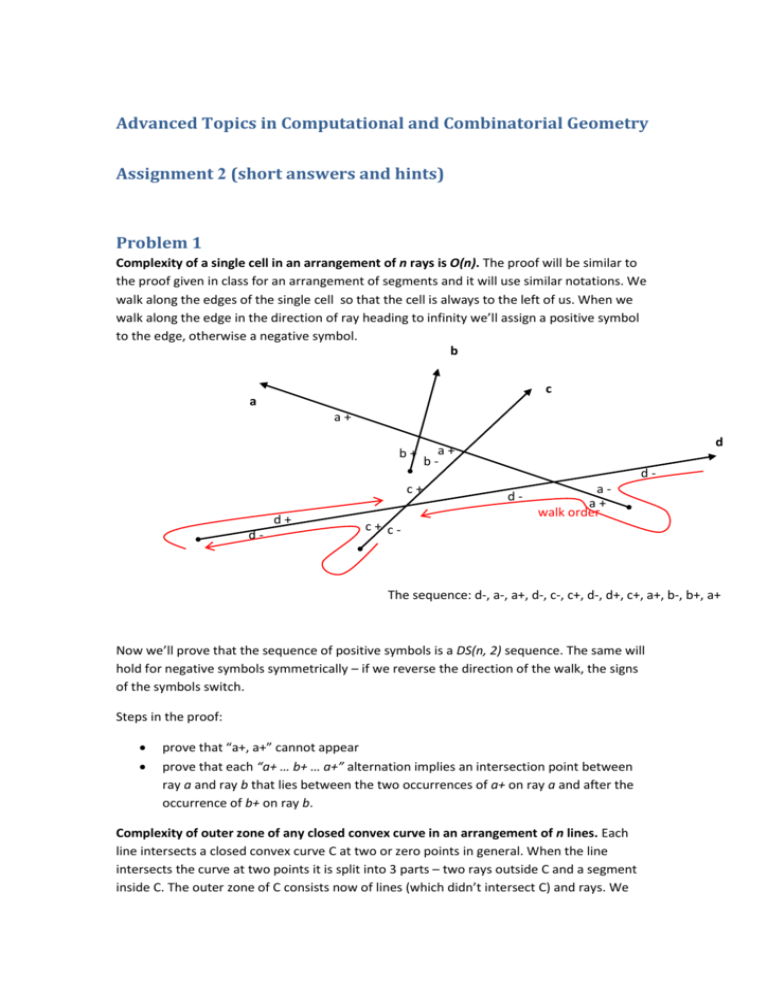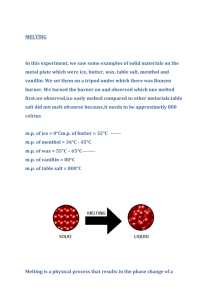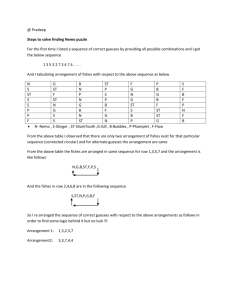Homework 2
advertisement

Advanced Topics in Computational and Combinatorial Geometry
Assignment 2 (short answers and hints)
Problem 1
Complexity of a single cell in an arrangement of n rays is O(n). The proof will be similar to
the proof given in class for an arrangement of segments and it will use similar notations. We
walk along the edges of the single cell so that the cell is always to the left of us. When we
walk along the edge in the direction of ray heading to infinity we’ll assign a positive symbol
to the edge, otherwise a negative symbol.
b
c
a
a+
b+
c+
d+
d-
d
a+
b-
dd-
aa+
walk order
c+ c-
The sequence: d-, a-, a+, d-, c-, c+, d-, d+, c+, a+, b-, b+, a+
Now we’ll prove that the sequence of positive symbols is a DS(n, 2) sequence. The same will
hold for negative symbols symmetrically – if we reverse the direction of the walk, the signs
of the symbols switch.
Steps in the proof:
prove that “a+, a+” cannot appear
prove that each “a+ … b+ … a+” alternation implies an intersection point between
ray a and ray b that lies between the two occurrences of a+ on ray a and after the
occurrence of b+ on ray b.
Complexity of outer zone of any closed convex curve in an arrangement of n lines. Each
line intersects a closed convex curve C at two or zero points in general. When the line
intersects the curve at two points it is split into 3 parts – two rays outside C and a segment
inside C. The outer zone of C consists now of lines (which didn’t intersect C) and rays. We
can split each of the untouched lines into 2 rays as well and then we have that the outer
zone is a single cell in the arrangement of 2n rays. So its complexity is O(n).
Problem 2
It is easy to see that the zone of a line in the arrangement of circles has at most 2n+1 cells.
We choose a point from each such cell – denote this set P, |P| = 2n+1. Complexity of the
zone of the line in the arrangement of upper half-circles is O(n α(n)) since each pair of upper
half-circles intersect in at most one point. The total complexity of all cells containing points
of P is also O(n α(n)) since they are the same cells as the cells of the zone. Same argument is
symmetrically valid for the arrangement of the lower half-circles. Using the combination
lemma we conclude that the complexity of all cells containing P in the combined
arrangement (i.e. the arrangement of the full circles) is
O(n α(n) + n α(n) + 2n + 1) = O(n α(n)), and so is the complexity of the zone of a line.
In the case the circles have arbitrary radii, the complexity of the zone is bounded by O(λ4(n)).
Problem 3
First note that the separation distance satisfies the triangle inequality.
a) Let p be a point located at separation distance k from x. By definition there are k
lines crossing px. Denote l be a line with closest intersection point to x, and denote q
be the intersection point. Line l has n intersection points with other lines from L.
Let’s take k closest intersection points to q. The separation distance between all
these points and q is at most k. Separation distance between q and x is 0, thus it
follows from triangle inequality that the separation distance of these k points to x is
at most k. I.e. line l contributed k points from the arrangement with separation
distance up to k. Applying the same argument to the next line, will show that it
contributes k – 1 points with separation distance up to k. Finally, all k lines together
will contribute
k + (k – 1) + (k – 2) + … + 1 = (k2) points.
b) Hint: Denote by d the minimal separation distance between any pair of points in P.
Define Si to be the set of vertices of the arrangement that are at distance at most
𝑑−1
⌋ from the i'th point.
2
𝑛
𝑛
𝑐 𝑚 ⟹ 𝑑 = 𝑂 ( 𝑚).
√
√
𝑘=⌊
𝑘≤
Clearly |S1|+…|Sm| ≤ n2, so by (a): 𝑚𝑐𝑘 2 ≤ 𝑛2 ⟹
c) SpanningTree(L, P):
1. Find a pair of points p,qP with minimal separation distance.
2. T = SpanningTree(L, P \ {p})
3. return T {(p, q)}
Problem 4
a) Hint: first prove only for the direction of the x-axis.
b) First prove that the Minkowski sum of two convex polygons is a convex polygon,
then use the normal diagram to prove that there are only 𝑛𝑖 + 𝑘 vertices.
c) Hint: prove that each common outer tangent to Ki and Kj has a corresponding outer
tangent to original polygons Ai and Aj. Since original polygons Ai and Aj do not
intersect – they have exactly two common outer tangents.







